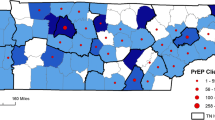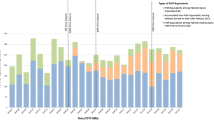Abstract
For marginalized populations, county health departments may be important PrEP access points; however, there are little data on successful PrEP programs at these venues outside of incentivized demonstration projects. Therefore, we implemented an open-access, free PrEP clinic at a county health department in Atlanta, GA to promote PrEP uptake among high-risk clients. The Fulton County Board of Health PrEP clinic launched in October 2015, and eligible clients who expressed interest initiated PrEP and attended follow-up visits per CDC guidelines. Clients engaged in quarterly follow-up and seen within the last 6 months were defined as “persistent”, whereas clients with a lapse in follow-up of > 6 months were defined as “not persistent.” Factors associated with PrEP persistence were assessed with unadjusted odds ratios. Between October 2015 and June 2017, 399 clients were screened for PrEP, almost all were eligible [392/399 (98%)]; however, 158/392 (40%) did not return to start PrEP after screening. Of 234 patients, 216 (92%) received a prescription for PrEP. As of June 2017, only 69/216 (32%) clients remained persistent in PrEP care, and the only evaluated factor significantly associated with PrEP persistence was age ≥ 30 years (OR 1.86, 95% CI 1.02, 3.42). Implementation of PrEP in the county health department setting is feasible; however, we have identified significant challenges with PrEP uptake and persistence in our setting. Further research is needed to fully understand mediators of PrEP persistence and inform interventions to optimize health department-based PrEP services.

Similar content being viewed by others
References
Centers for Disease Control and Prevention. HIV surveillance report, 2016, vol 28. http://www.cdc.gov/hiv/library/reports/surveillance/ (Nov 2017). Accessed 15 June 2018.
AIDSVu. www.aidsvu.org. Emory University, Rollins School of Public Health. https://aidsvu.org/state/georgia/atlanta/. Accessed 9 Jan 2017.
Hess KL, et al. Lifetime risk of a diagnosis of HIV infection in the United States. Ann Epidemiol. 2017;27(4):238–43.
United States Public Health Service. Pre-exposure prophylaxis for the prevention of HIV infection in the United States—2014: a clinical practice guideline. http://www.cdc.gov/hiv/pdf/prepguidelines2014.pdf. Accessed 12 Dec 2016.
Kelley CF, et al. Applying a PrEP continuum of care for men who have sex with men in Atlanta, Georgia. Clin Infect Dis. 2015;61(10):1590–7.
Rendina HJ, et al. Distinguishing hypothetical willingness from behavioral intentions to initiate HIV pre-exposure prophylaxis (PrEP): findings from a large cohort of gay and bisexual men in the US. Soc Sci Med. 2017;172:115–23.
Arnold T, et al. Social, structural, behavioral and clinical factors influencing retention in pre-exposure prophylaxis (PrEP) care in Mississippi. PLoS ONE. 2017;12(2):e0172354.
Hoots BE, et al. Willingness to take, use of, and indications for pre-exposure prophylaxis among men who have sex with men-20 US cities, 2014. Clin Infect Dis. 2016;63(5):672–7.
Kuehn B. PrEP disparities. JAMA. 2018;320(22):2304.
Siegler AJ, et al. The prevalence of pre-exposure prophylaxis use and the pre-exposure prophylaxis-to-need ratio in the fourth quarter of 2017, United States. Ann Epidemiol. 2018;28(12):841–9.
Huang YA, et al. HIV preexposure prophylaxis, by race and ethnicity—United States, 2014–2016. MMWR Morb Mortal Wkly Rep. 2018;67(41):1147–50.
Siegler AJ, et al. Location location location: an exploration of disparities in access to publicly listed pre-exposure prophylaxis clinics in the United States. Ann Epidemiol. 2018;28(12):858–64.
Ojikutu BO, et al. Spatial access and willingness to use pre-exposure prophylaxis among Black/African American individuals in the United States: cross-sectional survey. JMIR Public Health Surveill. 2019;5(1):e12405.
Rolle CP, et al. Challenges in translating PrEP interest into uptake in an observational study of young black MSM. J Acquir Immune Defic Syndr. 2017;76(3):250–8.
Rusie LK, et al. PrEP initiation and retention in care over five years, 2012-2017: are quarterly visits too much? Clin Infect Dis. 2018;67:283–7.
Doblecki-Lewis S, et al. Patterns and correlates of participant retention in a multi-city pre-exposure prophylaxis demonstration project. J Acquir Immune Defic Syndr. 2018;79:62–9.
Chan PA, et al. Retention in care outcomes for HIV pre-exposure prophylaxis implementation programmes among men who have sex with men in three US cities. J Int AIDS Soc. 2016;19(1):20903.
Hojilla JC, et al. HIV pre-exposure prophylaxis (PrEP) uptake and retention among men who have sex with men in a community-based sexual health clinic. AIDS Behav. 2018;22(4):1096–9.
Grinsztejn B, et al. Retention, engagement, and adherence to pre-exposure prophylaxis for men who have sex with men and transgender women in PrEP Brasil: 48 week results of a demonstration study. Lancet HIV. 2018;5(3):e136–45.
Huang YA, Tao G, Smith DK, Hoover KW. Persistence with HIV preexposure prophylaxis in the United States, 2012-2016. In: Conference on retroviruses and opportunistic infections, March 4–7, 2019, Seattle, WA, Abstract 106.
Coy KC, et al. Persistence on HIV preexposure prophylaxis medication over a 2-year period among a national sample of 7148 PrEP users, United States, 2015 to 2017. J Int AIDS Soc. 2019;22(2):e25252.
Serota DP, Rosenberg ES, Thorne AL, del Rio C, Luisi N, et al. PrEP persistence and discontinuation in a Cohort of young black men who have sex with men in Atlanta, GA. In: Conference on retroviruses and opportunistic infections (CROI), March 4–7, 2019, Seattle, WA, Abstract 963.
White House Office of National AIDS Policy. National HIV/AIDS strategy for the United States updated to 2020 (2015).
Weiss G, et al. PrEP implementation by local health departments in US cities and counties: findings from a 2015 assessment of local health departments. PLoS ONE. 2018;13(7):e0200338.
Nunn AS, et al. Defining the HIV pre-exposure prophylaxis care continuum. AIDS. 2017;31(5):731–4.
Liu AY, et al. Preexposure prophylaxis for HIV infection integrated with municipal- and community-based sexual health services. JAMA Intern Med. 2016;176(1):75–84.
Marcus JL, et al. Preexposure prophylaxis for HIV prevention in a large integrated health care system: adherence, renal safety, and discontinuation. J Acquir Immune Defic Syndr. 2016;73(5):540–6.
Centers for Disease Control and Prevention. Social determinants of health and selected HIV care outcomes among adults with diagnosed HIV infection in 32 states and the District of Columbia, 2014. HIV Surveill Suppl Rep. 2016;21(7):1–62.
Blackstock OJ, et al. Pre-exposure prophylaxis prescribing and retention in care among heterosexual women at a community-based comprehensive sexual health clinic. AIDS Care. 2017;29(7):866–9.
Hosek S, et al. An HIV pre-exposure prophylaxis (PrEP) demonstration project and safety study for young MSM. J Acquir Immune Defic Syndr. 2017;74(1):21–9.
Sullivan PS, et al. Implementation strategies to increase PrEP uptake in the South. Curr HIV/AIDS Rep. 2019;16:259–69.
Siegler AJ, Brock JB, Kelley CF, Ahlschlager LA, Rolle CPM, et al. Pilot test of a PrEP telmedicine system for young black MSM in the rural US South. In: Conference of retroviruses and opportunistic infections (CROI), March 4–7, 2019, Seatlle, WA, Abstract 955.
Marcus JL, et al. Disparities in uptake of HIV preexposure prophylaxis in a large integrated health care system. Am J Public Health. 2016;106(10):e2–3.
Jenness S, Maloney K, Smith DK, Hoover KW, Goodreau SM, Weiss K, Rosenberg ES, Sullivan PS. The PrEP care continuum and HIV racial disparities among men who have sex with men. In: Conference on retroviruses and opportunistic infections (CROI), March 4–7, 2018, Boston, MA, Abstract 1149.
Giler Mera R, Magnuson D, Trevor H, Bush S, Rawlings K, McCallister S. Changes in truvada (TVD) for HIV pre-exposure prophylaxis (PrEP) utilization in the United States: (2012-2016). In: 19th IAS conference on HIV science, 23–26 July 2017, Paris, France, Abstract 1614.
Sheth AN, Rolle CP, Gandhi M. HIV pre-exposure prophylaxis for women. J Virus Erad. 2016;2(3):149–55.
Flash CA, et al. Perspectives on HIV prevention among urban black women: a potential role for HIV pre-exposure prophylaxis. AIDS Patient Care STDS. 2014;28(12):635–42.
Hong JN, Farel CE, Rahangdale L. Pharmacologic prevention of human immunodeficiency virus in women: practical approaches for the obstetrician and gynecologist. Obstet Gynecol Surv. 2015;70(4):284–90.
Doblecki-Lewis S, et al. HIV risk and awareness and interest in pre-exposure and post-exposure prophylaxis among sheltered women in Miami. Int J STD AIDS. 2016;27(10):873–81.
Auerbach JD, et al. Knowledge, attitudes, and likelihood of pre-exposure prophylaxis (PrEP) use among US women at risk of acquiring HIV. AIDS Patient Care STDS. 2015;29(2):102–10.
Acknowledgements
We thank Diakima Thomas, and the FCBOH PrEP clinic staff for their contributions and feedback.
Funding
This work was supported by the National Institutes of Health: K23AI108335 (PI: Kelley) and K23AI114407 (PI: Sheth)
Author information
Authors and Affiliations
Corresponding author
Ethics declarations
Conflicts of interest
There are no conflicts of interest or financial disclosures for any author.
Additional information
Publisher's Note
Springer Nature remains neutral with regard to jurisdictional claims in published maps and institutional affiliations.
Rights and permissions
About this article
Cite this article
Rolle, CP., Onwubiko, U., Jo, J. et al. PrEP Implementation and Persistence in a County Health Department Setting in Atlanta, GA. AIDS Behav 23 (Suppl 3), 296–303 (2019). https://doi.org/10.1007/s10461-019-02654-x
Published:
Issue Date:
DOI: https://doi.org/10.1007/s10461-019-02654-x




